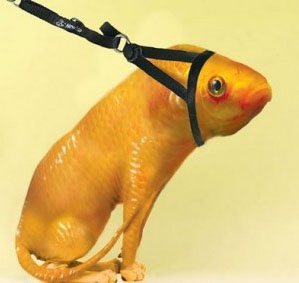“Here I come to save the daaaay! I’m not very mighty, I don’t fly (yet), but my DNA has been spliced with mouse DNA which means that my poop now has less environment-harming phosphorous. This allows me and my cohorts to continue being stacked in barns to the brim – no dietary changes necessary! Soon my mutated flesh will be a tender morsel on your plate but you won’t even know it’s me.”
Enter Enviropig! And his trusty side-kick Super Fish!
Genetically mutated plants and animals always start out as some sort of trial – “Oh we would never allow this on the dinner plate,” is always the beginning line. Blink and you’ll miss the critters crawling onto the grocers’ shelves. Most of us are unaware of our consumption of GM vegetation. The push and final release of GM salmon will be the precedent that allows Enviropig on the market. The supposed intention behind Enviropig is the environment, but that’s a giant load of steaming hog manure, otherwise the pigs themselves would be given better treatment and diets to lower phosphorous waste.Some speculate that the Corn Refiners Association is the influence behind the pigs’ mostly corn-fed diet that attributes to the highly phosphorous poo. Instead of different food and free range, the answer is to create labs, hire scientists, and mix them with mice?
“It is estimated that if just 60 genetically engineered salmon were released, the wild population of salmon could be extinct in forty generations.” Future of Food These genetically “enhanced” animals, as the media often calls them, have no benefit for human consumption; no added nutrient value, etc. GM products were often lauded as the way to end world hunger, but world hunger has nothing to do with the unavailability of food. It has everything to do with a country’s government and that other countries cannot continue to sustain their agriculture with loans from the World Bank.
Health officials and GM research firms are pushing hard and fast for the animals’ widespread use without one iota of thought or impartial testing of the future impact on the environment, animal kingdom, and human species. We’d like to think that such an ecologic and environmental travesty would only happen when pigs fly – but it might just be sooner than you think. ~Health Freedoms
OTTAWA, CANADA – The federal government is refusing to say whether it is close to approving genetically modified animals for human consumption. But if they do, you may never know it.
So far, groups have applied to get approval for fish that grow twice as fast as normal, and pigs with mice DNA spliced into them.
“For confidentiality reasons, Health Canada cannot confirm whether or not a submission has been filed or any other information related to a submission,” said Jenny Van Alstyne, spokeswoman for Health Minister Leona Aglukkaq.
This week, media reports revealed that scientists in the department of fisheries and oceans raised doubts about approving genetically modified fish over concerns the fish could escape from fish farms and mate with natural Canadian fish stock.
AquaBounty, a firm with Canadian and U.S. operations, made the application.
AquaBounty’s website claims the company is also working on developing hybrid salmon, trout and tilapia, which will also grow faster than traditional fish.
The application for a genetically modified pig comes from the University of Guelph. Called Enviropig, researchers spliced DNA from mice into Yorkshire pigs to reduce the amount of phosphorous in swine’s manure.
The researchers hope the reduced phosphorous will mean less pollution in rivers and streams near large-scale pig farms.
Under current regulations, there would be no requirement to tell the public the animals they are eating are anything other than a regular fish or pigs.
“Consumers have a right to know what they are eating,” said MP Alex Atamanenko, the NDP agriculture and food security critic.
Atamanenko called on the government to put a moratorium on all genetically modified foods, calling them a health hazard.
“I think it would be a travesty if the government would allow this to happen without letting consumers know what they are eating.
“I think it’s absurd to release a genetically modified salmon or pig into the environment,” said Atamanenko. “There¹s no way to separate a genetically modified salmon from regular salmon.”
By BRIAN LILLEY, Parliamentary Bureau
http://www.torontosun.com/news/canada/2011/02/23/17383726.html
http://news.nationalgeographic.com/news/2010/03/100330-bacon-pigs-enviropig-dead-zones/
http://eatocracy.cnn.com/2010/09/25/enviropig-the-next-transgenic-food/
![]()

